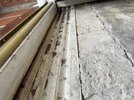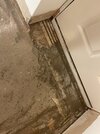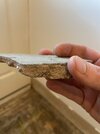Hi
I’m in the process of laying wood flooring and after taking up the carpet and underlay I found the screed and concrete on the floor inside the front door was crumbling away. I’ve cleared it up and found this plastic item which was filled with concrete.
Can anyone tell me what this is and it it supposed to be where it is?
You’ll see in the photos it’s concrete, then a layer of breeze blocks, then this plastic item (not sure what’s underneath), then the door frame.
The plastic item runs up the walls on both sides of the wall also.
Any advice gratefully received!
I’m in the process of laying wood flooring and after taking up the carpet and underlay I found the screed and concrete on the floor inside the front door was crumbling away. I’ve cleared it up and found this plastic item which was filled with concrete.
Can anyone tell me what this is and it it supposed to be where it is?
You’ll see in the photos it’s concrete, then a layer of breeze blocks, then this plastic item (not sure what’s underneath), then the door frame.
The plastic item runs up the walls on both sides of the wall also.
Any advice gratefully received!







